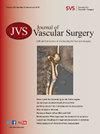Computed tomography-based anatomical suitability of an Endo-Bentall prosthesis for ascending aortic aneurysms
IF 3.9
2区 医学
Q1 PERIPHERAL VASCULAR DISEASE
引用次数: 0
Abstract
Background
This study aimed to evaluate the suitability of a coronary-branched ascending aortic endograft, paired with aortic valve (AV) prosthesis (Endo-Bentall), for the endovascular repair of ascending aortic aneurysms.
Methods
Preoperative ≤1 mm computed tomography angiographies of consecutive patients managed with Bentall procedure or ascending aortic replacement and AV reconstruction/replacement, in a single institution (from January 1, 2008, to December 31, 2023), were retrospectively analyzed. Dedicate software was used to assess (1) vascular access, (2) proximal landing zone, (3) coronary artery anatomy, and (4) distal landing. Eligibility criteria for Endo-Bentall were ≥8 mm iliac arteries, without severe calcification/tortuosity, proximal landing with an 18- to 29-mm aortic annulus diameter, ≥10 mm annulus-coronary ostium distance, no mechanical AV, absence of coronary grafts in the ascending aorta, no left ventricle thrombus, coronary arteries ≥3 mm wide and ≥10 mm long, with no anatomical abnormalities, ostial stent or stenosis, and ≥20 mm long and ≤38 mm wide distal landing zone within the ascending aorta or applicability of branched endovascular arch repair.
Results
Twenty-nine patients (55.2% females) were included. All patients had adequate proximal landing zone in terms of annulus diameter (median, 25 mm; interquartile range [IQR], 5 mm). Two (6.8%) had inadequate iliac access (external iliac artery <8 mm). Two patients (6.8%) had a mechanical AV. Twenty-six patients (89.6%) had adequate landing zone for stenting of the left main coronary artery (median diameter, 5.2 mm; IQR, 1.8 mm) and 28 (96.6%) had adequate right coronary artery landing (median diameter, 4.1 mm; IQR, 1 mm). The left main coronary artery and right coronary artery were located at 5:00 minute and 10:50 minute clock positions, respectively. Three patients (20.7%) had an adequate distal landing zone within the ascending aorta. The remaining were suitable for extension with a branched arch device. According to the predefined criteria, 75.9% of patients were anatomically suitable for Endo-Bentall.
Conclusions
Three out of four patients with ascending aortic aneurysms may be considered as anatomically eligible for endovascular treatment with an Endo-Bentall prosthesis.
基于计算机断层扫描的 Endo-Bentall 假体对主动脉升主动脉瘤的解剖适用性。
简介本研究旨在评估冠状支主动脉升主动脉内膜移植与主动脉瓣(AV)假体(Endo-Bentall)配对用于升主动脉瘤血管内修复的适用性:方法:对一家医疗机构(2008 年 1 月 1 日至 2023 年 12 月 31 日)连续接受 Bentall 手术或升主动脉置换术和 AV 重建/置换术的≤1 毫米患者的术前计算机断层扫描血管造影进行回顾性分析。使用专用软件评估:(1) 血管通路;(2) 近端着床区;(3) 冠状动脉解剖;(4) 远端着床。Endo-Bentall 的合格标准是髂动脉≥8毫米,无严重钙化/迂曲,近端着床时主动脉瓣环直径为18-29毫米,瓣环-冠状动脉骨膜距离≥10毫米,无机械性房室,升主动脉内无冠状动脉移植物,无左心室血栓、冠状动脉宽≥3mm,长≥10mm,无解剖异常、支架或狭窄,升主动脉远端着床区长≥20mm,宽≤38mm,或适用于分支血管内弓修复。结果:共纳入 29 例患者(女性占 55.2%)。就瓣环直径而言,所有患者都有足够的近端着床区(中位数:25 毫米,IQR:5 毫米)。两名患者(6.8%)的髂动脉通路(髂外动脉)不足:四名升主动脉瘤患者中有三名在解剖学上符合使用 Endo-Bentall 假体进行血管内治疗的条件。
本文章由计算机程序翻译,如有差异,请以英文原文为准。
求助全文
约1分钟内获得全文
求助全文
来源期刊
CiteScore
7.70
自引率
18.60%
发文量
1469
审稿时长
54 days
期刊介绍:
Journal of Vascular Surgery ® aims to be the premier international journal of medical, endovascular and surgical care of vascular diseases. It is dedicated to the science and art of vascular surgery and aims to improve the management of patients with vascular diseases by publishing relevant papers that report important medical advances, test new hypotheses, and address current controversies. To acheive this goal, the Journal will publish original clinical and laboratory studies, and reports and papers that comment on the social, economic, ethical, legal, and political factors, which relate to these aims. As the official publication of The Society for Vascular Surgery, the Journal will publish, after peer review, selected papers presented at the annual meeting of this organization and affiliated vascular societies, as well as original articles from members and non-members.

 求助内容:
求助内容: 应助结果提醒方式:
应助结果提醒方式:


